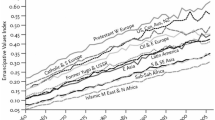Abstract
In the debate about whether distancing has occurred between American Jewry and Israel one of the two sides is more convincing than the other, but both sides focus on samples of the more identified Jewish population thus ignoring the more marginal that are quite crucial in adjudicating this debate. Age specific cross-sectional data from the more broadly representative NJPS unequivocally show a blurring among the younger of the strong sense of interest, affective involvement, responsibility and caring that American Jewry historically displayed toward Israel and its needs. However, the demonstrable existence of similar patterns of Jewish identification in the U.S. and in Israel provides powerful evidence to persisting coherence in contemporary symbolic and institutional perceptions over the opposite thesis of a Jewish identification stemming from the variable circumstances of local contexts. Jews in the U.S. and in Israel may be distancing from each other, but they still are part of one Jewish peoplehood.


Similar content being viewed by others
Notes
For some of the following materials I am indebted to my colleagues Shlomit Levy, Uzi Rebhun and Dalia Sagi.
References
Cohen, S.M., and A.Y. Kelman. 2010. Thinking about distancing from Israel. Contemporary Jewry. doi:10.1007/s12397-010-9053-4.
DellaPergola, S. 2005. Was it the demography? A reassessment of U.S. Jewish population estimates, 1945–2001. Contemporary Jewry 25: 85–131.
DellaPergola, S. 2008. World Jewish population 2008. In American Jewish year book, vol. 108, ed. D. Singer, and L. Grossman, 569–620. New York: American Jewish Committee.
DellaPergola, S., S. Levy, U. Rebhun, and D. Sagi. 2009. Patterns of Jewish identification in the United States, 2001. In Theory construction and multivariate analysis: Applications of facet approach, ed. D. Elizur, and E. Yaniv, 305–318. Tel Aviv: FTA Publications.
Guttman, L. 1968. A general nonmetric technique for finding the smallest coordinate space for a configuration of points. Psychometrika 33: 469–506.
Kadushin, C., B.T. Phillips, and L. Saxe. 2005. National Jewish population survey 2000–01: A guide to the perplexed. Contemporary Jewry 25: 1–32.
Kosmin, B.A., and A. Keysar. 2009. American religious identification survey (ARIS 2008). Hartford: Program on Public Values, Trinity College.
Kotler-Berkowitz, L., S.M. Cohen, J. Ament, V. Klaff, F. Mott, and D. Peckermen-Neuman. 2003. The National Jewish Population Survey 2000–01: Strength, challenge and diversity in the American Jewish community. New York: United Jewish Communities.
Levy, S. 2008. Smallest space analysis of Jewish identification indicators in Israel 2000. Unpublished paper, The Hebrew University, Jerusalem.
Levy, S., H. Levinsohn, and E. Katz. 2002. A portrait of Israeli Jewry: Beliefs, observances, and values among Israeli Jews 2000. Jerusalem: The Guttman Center of the Israel Democracy Institute for The Avi Chai Foundation.
Mayer, E., B. Kosmin, and A. Keysar. 2002. American Jewish Identity Survey: An exploration in the demography and outlook of a people. New York: The Graduate Center of the City University of New York.
Rebhun, U. 2001. Recent developments in Jewish identification in the United States: A cohort follow-up and facet analysis. In Papers in Jewish Demography 1997, ed. S. DellaPergola, and J. Even, 261–279. Jerusalem: The Hebrew University of Jerusalem.
Rebhun, U., and S. Levy. 2005. Unity and diversity: Jewish identification in America and in Israel 1990–2000. Sociology of Religion 67(4): 391–414.
Sasson, T., C. Kadushin and L. Saxe. 2010. Trends in American Jewish attachment to Israel: An assessment of the “distancing” hypothesis. Contemporary Jewry. doi:10.1007/s12397-010-9056-1.
Thighe, E., C. Kadushin, and L. Saxe. 2009. Jewish population in the US 1990 vs 2000. Waltham: Steinhardt Social Research Institute, Brandeis University.
Author information
Authors and Affiliations
Corresponding author
Rights and permissions
About this article
Cite this article
DellaPergola, S. Distancing, Yet One. Cont Jewry 30, 183–190 (2010). https://doi.org/10.1007/s12397-010-9038-3
Received:
Accepted:
Published:
Issue Date:
DOI: https://doi.org/10.1007/s12397-010-9038-3




